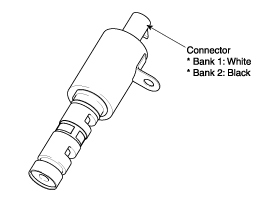Hyundai Genesis: Engine Control System / CVVT Oil Control Valve (OCV) Description and Operation
Hyundai Genesis (DH) 2013-2016 Service Manual / Engine Control / Fuel System / Engine Control System / CVVT Oil Control Valve (OCV) Description and Operation
| Description |
Continuous Variable Valve Timing (CVVT) system advances or
retards the valve timing of the intake and exhaust valve in accordance
with the ECM control signal which is calculated by the engine speed and
load.
By controlling CVVT, the valve over-lap or under-lap occurs,
which makes better fuel economy and reduces exhaust gases (NOx, HC) and
improves engine performance through reduction of pumping loss, internal
EGR effect, improvement of combustion stability, improvement of
volumetric efficiency, and increase of expansion work.
This system consists of
- the CVVT Oil Control Valve (OCV) which supplies the engine
oil to the cam phaser or spills the engine oil from the cam phaser in
accordance with the ECM PWM (Pulse With Modulation) control signal,
- the CVVT Oil Temperature Sensor (OTS) which measures the engine oil temperature,
- and the Cam Phaser which varies the cam phase by using the hydraulic force of the engine oil.
The engine oil which is supplied through the CVVT oil control
valve varies the cam phase in the direction (Intake Advance/Exhaust
Retard) or opposite direction (Intake Retard/Exhaust Advance) of the
engine rotation by rotating the rotor connected with the camshaft inside
the cam phaser.

 Purge Control Solenoid Valve (PCSV) Repair procedures
Purge Control Solenoid Valve (PCSV) Repair procedures
Inspection
1.
Turn the ignition switch OFF.
2.
Disconnect the PCSV connector.
3.
Measure resistance between the PCSV terminals 1 and 2.
4.
Check that the resistance is within the speci ...
 CVVT Oil Control Valve (OCV) Specifications
CVVT Oil Control Valve (OCV) Specifications
Specification
ItemSpecificationCoil Resistance (?)6.9 ~ 7.9 [20°C(68°F)]
...
Other information:
Hyundai Genesis (DH) 2013-2016 Owners Manual: Door / Hood / Trunk Open. Sunroof Open. Window Open
Door / Hood / Trunk Open • It means that any door, hood, or trunk is open. Sunroof Open • This warning message illuminates if you turn off the engine when the sunroof is open. Window Open • This warning message illuminates if you turn off the engine when any window is open ...
Hyundai Genesis (DH) 2013-2016 Service Manual: Front LCD monitor Repair procedures
Removal Take care not to scratch the crash pad and related parts. 1. Disconnect the negative (-) battery terminal. 2. Remove the crash pad side garnish assembly. (Refer to Body - "Crash pad side garnish assembly") In case of working on the non ...
© 2013-2025 www.hgenesisdh.com
